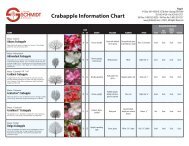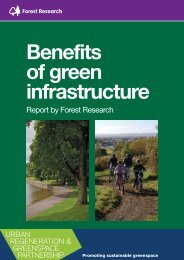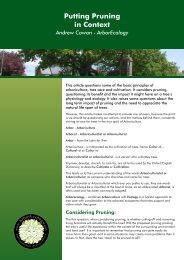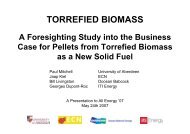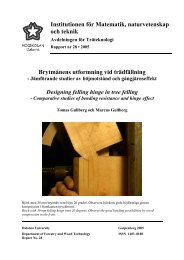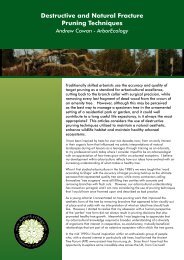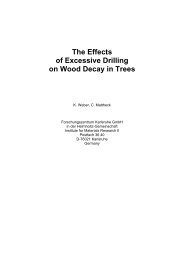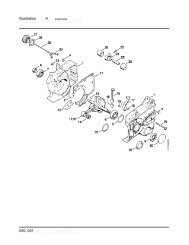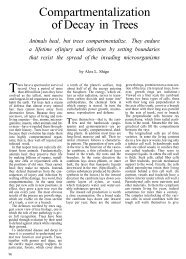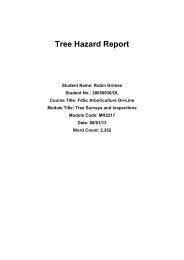Ganoderma on Trees.pdf - Arbtalk
Ganoderma on Trees.pdf - Arbtalk
Ganoderma on Trees.pdf - Arbtalk
You also want an ePaper? Increase the reach of your titles
YUMPU automatically turns print PDFs into web optimized ePapers that Google loves.
© Copyright F.W.M.R Schwarze and D. Ferner May 2003fungi. The same device had been used prior to incubati<strong>on</strong> in order to bore holes in R-z<strong>on</strong>es in <strong>on</strong>e series of the wood blocks. As in the assessment of decay across theradius of a standing tree, the pattern of drilling resistance al<strong>on</strong>g the length of eachblock provided a means of mapping the intensity of wood decompositi<strong>on</strong> (Fig. 10).However, the values for high drilling resistance (in unaltered wood and R-z<strong>on</strong>es) andlow resistance (decayed wood) were relative and not absolute, since the readings weredependent partly <strong>on</strong> the sharpness of the probe and the c<strong>on</strong>diti<strong>on</strong> of the rechargeablebattery. As shown in Fig. 11A-F, the measurements of resistance amplitude allowedthe following observati<strong>on</strong>s:A. In all cases, the tracings showed a transiti<strong>on</strong> between the R-z<strong>on</strong>e and thesapwood. The R-z<strong>on</strong>e showed a peak value, probably due to the presence ofdeposited compounds (mainly polyphenolics), which was clearly highest in thecase of G. applanatum which, unlike G. resinaceum and G. adspersum, wasunable to modify these compounds.B. In the blocks incubated with G. resinaceum, the R-z<strong>on</strong>e peak, althoughdistinct, was somewhat lower than in the case of G. applanatum; this reflectsthe moderate ability of G. resinaceum to degrade the polyphenoliccompounds.C. The measurements indicate clearly which z<strong>on</strong>es of the wood blocks werestr<strong>on</strong>gly decomposed. In the case of G. adspersum, the peak within the R-z<strong>on</strong>e was very low and broad, indicating that this fungus was able to degradethe polyphenolic compounds successfully and then to col<strong>on</strong>ise the sapwood.Interestingly, the sapwood c<strong>on</strong>tained amplitude peaks as great as the peakwithin the R-z<strong>on</strong>e.D. Although the R-z<strong>on</strong>e was more easily penetrated by the fungi when predrilled,it still showed a recognisable peak <strong>on</strong> the tracing. This was mostmarked in the case of G. applanatum, due to its inability to degrade thepolyphenolic compounds in the R-z<strong>on</strong>e. Penetrati<strong>on</strong> of the R-z<strong>on</strong>e did,however, enhance fungal col<strong>on</strong>isati<strong>on</strong> of the sapwood, which showed a lowamplitude <strong>on</strong> the tracing.E. In the blocks incubated with G. resinaceum, the R-z<strong>on</strong>e peak, althoughdistinct, was somewhat lower than in the case of G. applanatum; this reflectsthe ability of G. resinaceum to degrade the polyphenolic compounds.For further informati<strong>on</strong> please c<strong>on</strong>tact Page 9 of 21ENSPEC Pty Ltd <strong>on</strong> craig.hallam@enspec.com



